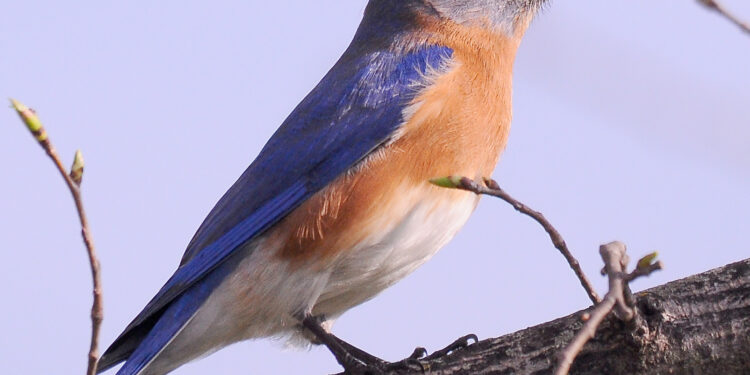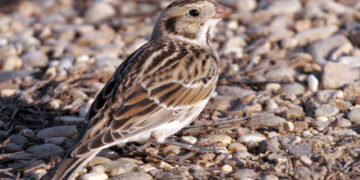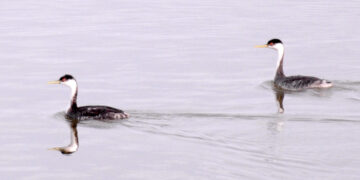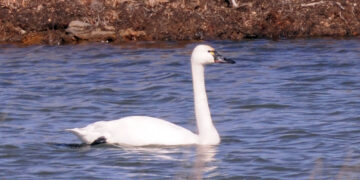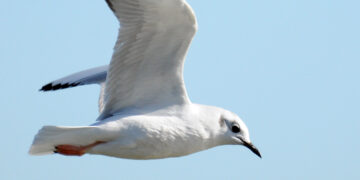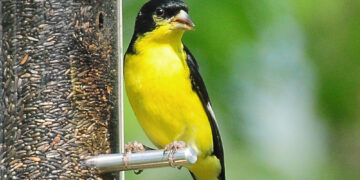This week’s featured creature is a common permanent resident in southwestern Oklahoma.
However, the eastern bluebird’s abundance doesn’t take away from the fact that it is a beautiful songbird. This honor belongs mostly to males as they are more colorful than females, a trait typical of most birds.
However, although females’ colors are more subdued, they have an elegant look in their own right.
The eastern bluebird is a thrush, related to birds such as robins and, well, thrushes.
Bluebirds do not often visit backyard feeders unless meal worms are offered. They especially enjoy mealworms which are alive. Although they occasionally show up at feeders — mostly for mealworms, fruit, suet and peanut hearts — the best way to attract bluebirds to a yard, in my opinion, is to offer a water feature, such as a simple bird bath. Bird baths and other water features will often attract birds that don’t commonly visit feeders.
Appearance
Male eastern bluebirds are a brilliant blue above, with chestnut throats, chests and flanks. Females have gray heads and are grayish above overall, with faint chestnut breasts and flanks. Females do have some blue on the wings and tails as well.
Immature birds look quite a bit different than their parents and, to the unfamiliar eye, they appear to be a different species altogether. They are darker gray above than females and have quite a bit of spotting over their chests and backs. There is also variable blue coloring on their wings and tails.
Range
Eastern bluebirds can be found all over Oklahoma. Their permanent range extends from the Great Plains states to the East Coast, covering the southeastern United States. Some birds migrate west a few hundred miles, and their breeding range extends just up into Canada.
Habitat
I frequently see eastern bluebirds around my house, which is no surprise as the vegetation is among their preferred habitat — trees with little understory and sparse ground cover. But perhaps the most preferred habitat is open country with scattered trees.
Food
Eastern bluebirds most often perch somewhat low to the ground, then fly out to catch prey, which is mostly insects. However, they sometimes perch a little higher, such as on electric lines.
Once an insect is spotted, a bluebird usually flies down to the ground to grab it up, then flies back to its perch. During my observations, small caterpillars were the most popular bluebird food.
However, the Cornell Lab of Ornithology reports that beetles, grasshoppers, crickets and spiders are also taken.
The Cornell Lab also reports that, in fall and winter, bluebirds eat large amounts of fruit including mistletoe, sumac, blueberries, black cherry, tupelo, currants, wild holly, dogwood berries, hackberries, honeysuckle, bay, pokeweed and juniper berries.
Nesting
Eastern bluebirds nest in tree cavities and manmade nesting boxes.
The Cornell Lab reports that a male attracts a female to the nesting cavities with a display in which he carries bits of nesting material into and out of the nest. Once a female enters the nest hole with him, the pair’s bond is typically established and often remains intact for several seasons.
The Lab also reports that boxes and tree cavities where bluebirds nest are a hot commodity among other birds that require holes for nesting. Male bluebirds will attack other species they deem a threat, including house sparrows, European starlings, tree swallows, great crested flycatchers, Carolina chickadees and brown-headed nuthatches, as well as non-cavity nesters such as robins, blue jays, mockingbirds and cowbirds, according to the Lab.
However, I’ve seen tree cavity nesters, like Carolina chickadees, nesting in nearby trees, and they seemed to live in peace with bluebirds. I guess as long as the other birds aren’t in competition with a bluebird pair’s preferred residence, it’s okay.
Females lay two to seven eggs, which are incubated for 11 to 19 days, according to the Cornell Lab. Young are ready to leave the nest at about three weeks of age. However, I’ve witnessed adult eastern bluebirds assisting their young with hunting and feeding for several weeks after the young have left the nest.
Nest boxes
Nest boxes for eastern bluebirds should be built to exact specifications. This lessens the likelihood of other bird species moving in and taking over. They should also be erected well before the breeding season.
For more information on building a bluebird house, visit www.nestwatch.org/ and search for eastern bluebird. You can also visit the North American Bluebird Society at http://www.nabluebirdsociety.org./
Odds and ends
– Bluebirds can sight their preferred prey from 60 feet or more away, according to ornithologists.
– Eastern bluebird populations were once in great decline due to human behavior — introduced bird species, habitat loss and pesticides — according to the American Bird Conservancy. However, also due to human behavior, they have made a great comeback. The comeback was due in large part to the offering of artificial nest boxes.
Editor’s Note: Randy Mitchell is a freelance writer and photographer. He has been an avid birdwatcher, nature enthusiast and photographer for more than 40 years. Reach him at [email protected].
Want to reach a local audience and grow your business?
Our website is the perfect platform to connect with engaged readers in your local area.
Whether you're looking for banner ads, sponsored content, or custom promotions, we can tailor a package to meet your needs.
Contact us today to learn more about advertising opportunities!
CONTACT US NOW